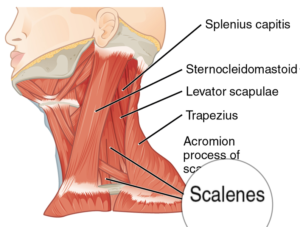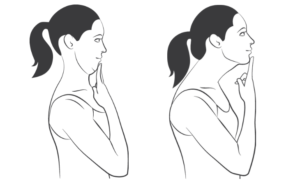Got Numb Fingers? It Could Be Your Neck!
If you’re feeling numbness or tingling in your fingers, the culprit might not be where you think. The often-overlooked scalene muscles in your neck could be to blame. These lateral neck muscles help with essential movements like inhaling, rotating, and flexing your head forward. Unfortunately, modern habits like prolonged sitting, driving, and staring at phones cause these muscles to tighten, leading to issues like thoracic outlet syndrome and numb fingers.
But don’t worry—this guide will walk you through how to release your tight scalene muscles and finally relieve that nagging discomfort.
How Tight Scalenes Affect Your Body

Forward head posture is a common culprit behind tight scalenes. Whether you’re driving, working at a desk, or using your smartphone, your head naturally juts forward, causing the scalenes to shorten and tighten.
Over time, this tension can lead to chronic pain and stiffness in the neck and shoulders, further aggravating muscle imbalance and nerve compression.
This postural misalignment compresses the brachial plexus, a network of nerves extending from the neck down to the arms, potentially leading to:
- Numbness in the fingers
- Thoracic outlet syndrome
- Carpal tunnel-like symptoms
When left untreated, tight scalenes can further restrict blood flow and nerve function, intensifying the severity of these symptoms. Fortunately, by learning how to release tight scalene muscles, you can address these issues before they escalate, restoring proper posture and reducing nerve compression. Regular stretching, targeted massage, and improved breathing techniques are key to long-term relief.
Anatomy of the Scalene Muscles
 The scalene muscles are located between the anterior trapezius and the sternocleidomastoid muscles, forming a triangular region along the side of the neck.
The scalene muscles are located between the anterior trapezius and the sternocleidomastoid muscles, forming a triangular region along the side of the neck.
Often referred to as the “anatomical Bermuda Triangle,” this area can be tricky for massage therapists to treat because of its proximity to sensitive structures like the carotid artery and the brachial plexus.
Many massage schools caution students to avoid working directly on the anterior neck due to the risk of pressing on the carotid artery. However, with the right training and experience, a skilled therapist can confidently target the scalenes to release tension and alleviate pain without risking injury.
During my time at the Bancroft School of Massage Therapy, I learned precise techniques to safely locate and treat tight scalenes. As an orthopedic massage therapist, I can effectively address these muscles, providing relief from discomfort and improving neck mobility.
What Causes Tight Scalenes?
Scalene muscles, located on the sides of your neck, play a critical role in head movement and breathing. However, these muscles can become tight due to a variety of everyday habits and physical stressors.

When this happens, they can trap nearby nerves and blood vessels, like the brachial plexus and subclavian artery, leading to symptoms like numbness, tingling, or even pain radiating down your arm.
Forward head posture is one of the most common reasons for tight scalenes. Whether you’re sitting at a desk or hunched over your phone, your head tends to jut forward, causing the scalenes to shorten.
Over time, this tension builds up, restricting space in the thoracic outlet—the narrow passage where nerves and blood vessels travel from your neck to your arm. This can lead to thoracic outlet syndrome, which often results in numbness or tingling in the hands and arms.
Other factors can also trigger tight scalenes, including:
- Leg length discrepancies, which throw off your body’s alignment.
- Whiplash injuries, which cause sudden trauma to the neck.
- Bad sleeping habits, like sleeping on your stomach with your arm raised.
- Excessive coughing, which strains the neck muscles.
- Carrying heavy bags or lifting improperly, especially if you’re lugging items like a large purse or backpack.
If the scalenes tighten more on one side (a unilateral issue), you might notice an elevated shoulder or a lopsided posture. This imbalance often results from compensating for other issues, like poor alignment, or simply carrying a heavy load unevenly, leading to chronic muscle tension.
Another critical factor in tight scalene muscles is how you breathe. If you’re breathing shallowly—using your chest muscles rather than your diaphragm—the scalenes work overtime to help you inhale. This can cause them to become overactive and tight, further contributing to pain and discomfort. Assessing and improving your breathing patterns is key to preventing and treating scalene tension.
How to Release Scalene Muscles
Here are some of the best strategies to release tight scalene muscles and improve your overall comfort:
1. Diaphragmatic Breathing
Abnormal breathing patterns contribute significantly to tight scalenes. By learning to breathe properly, you can relieve tension and prevent trigger points from forming. Follow these steps:
- Place your right hand on your chest and your left hand on your abdomen.
- Inhale through your nose for 4 seconds, expanding your abdomen.
- Exhale slowly through your mouth for 4 seconds.
- Repeat this exercise for 30-60 seconds each hour.
Diaphragmatic breathing helps relax the scalenes, making it a simple yet powerful technique for releasing tension.
2. Correct Forward Head Posture with Chin Tucks

One of the simplest and most effective exercises for correcting forward head posture and releasing tight scalene muscles is the chin tuck. This movement helps elongate the scalenes, strengthens neck muscles, and promotes better alignment.
By regularly practicing chin tucks, you can also improve your overall posture and reduce tension in your upper back and shoulders. Over time, this can lead to better mobility and a noticeable reduction in neck and shoulder discomfort.
Here’s how to do it:
- Sit or stand up straight with your shoulders relaxed. Imagine a string gently pulling the top of your head toward the ceiling, keeping your spine long and aligned.
- Slowly tuck your chin toward your chest, as if you’re trying to create a double chin. You don’t need to force it; think of it as a gentle backward glide of your head.
- A helpful way to visualize this is to imagine a chicken clucking, where its head moves back and forth in a subtle, controlled manner. Your goal is to replicate that smooth backward motion, avoiding any jerky movements.
- Hold the tuck for 5 seconds, feeling a light stretch along the back of your neck.
- Release and return to your neutral position slowly, allowing your head to glide forward again.
- Repeat 10 times, aiming for 2-3 sets each day.
This exercise, though simple, can make a big difference over time. Like a chicken’s rhythmic clucking motion, the chin tuck promotes smooth and controlled neck movement, helping to realign your head and release tension in your scalenes. Done consistently, it strengthens your neck muscles and improves posture, preventing forward head syndrome from becoming a recurring issue.
3. Getting Rid of Scalene Trigger Points with Massage
For more direct relief, massage therapy can be extremely beneficial. A licensed massage therapist can use techniques like compression and stripping to release trigger points in the scalene muscles. Regular massage can also prevent further issues such as carpal tunnel syndrome and tennis elbow.
Additional Tips for Scalene Muscle Relief
In addition to exercises and massage, consider these daily adjustments to prevent your scalenes from tightening again:
- Limit your screen time and be mindful of your posture while using devices.
- Avoid sleeping on your stomach with your arms raised, as this can aggravate the scalenes.
- Use ergonomic chairs and standing desks to encourage better posture throughout the day.
- Hold babies or heavy objects properly to prevent uneven strain on the neck muscles.
By addressing these lifestyle habits, you’ll reduce the strain on your scalenes and prevent further discomfort.
Final Thoughts: Restore Comfort by Releasing Scalene Muscles
Tight scalene muscles are a common issue in today’s fast-paced, tech-heavy world, but they don’t have to be a permanent source of discomfort. With the right exercises, breathing techniques, and professional massage therapy, you can release your scalenes and alleviate issues like numb fingers, neck pain, and thoracic outlet syndrome.
Don’t let tight scalenes hold you back—take action today by practicing these techniques and booking a professional massage session.
Book an in-home massage with Morgan Massage today to get the relief you deserve!

